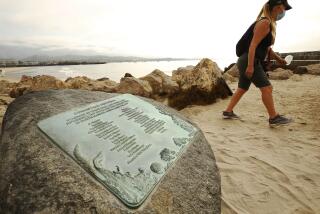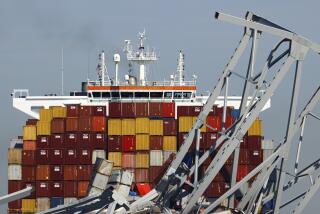Riveting testimony on oil rig rescue effort
Reporting from Kenner, La. — Workers leaped eight stories into the sea as flames engulfed the Deepwater Horizon oil drilling rig, according to gripping testimony Tuesday during a federal hearing into last month’s Gulf of Mexico disaster.
The testimony in a crowded ballroom here painted a picture of chaos mixed with heroism in the aftermath of an explosion of natural gas. Nearby ships raced to the scene unfolding 50 miles offshore as the crew of a solitary supply boat plucked survivors from burning water, witnesses said.
The hearing, convened by the Coast Guard and the federal Minerals Management Service, offered the first broad public view of the events that led to a spill already measuring more than 4 million gallons of oil and threatening the fragile wetlands of Louisiana and its multimillion-dollar fishery. Eleven men are missing and presumed dead after the April 20 explosion and sinking of the rig two days later.
In the morning session, the captain and crew of the Damon B. Bankston told about 200 people how they scrambled to save rig workers and coordinate early rescue efforts. A Coast Guard official described doctors on the decks of rocking boats desperately performing triage of the burned and injured, and a four-day round-the-clock search that covered 5,300 square miles.
The afternoon session was dominated by legal sparring among several companies with potential liability, including BP, which owns the oil lease; Transocean, which owns the rig; Halliburton, which applied the cement that is suspected of being a factor in the explosion; and Cameron, which manufactured the blowout preventer atop the well, which may have failed.
Coast Guard search-and-rescue specialist Kevin Robb said he was home after working a 12-hour shift when he got a call to return to handle a rig fire. The incident escalated into a massive rescue effort, and Robb said the Coast Guard called in every available helicopter to begin a nighttime search of the gulf. Pilots were flying with night-vision goggles, and other aircraft were fitted with radar equipment that detected heat to aid in finding anyone in the water. The task was enormous, he said.
“What you are looking for in these circumstances is about the size of a volleyball — a person’s head,” Robb said.
Alwin Landry was the captain of the Damon B. Bankston, a supply boat alongside the oil rig. He said he was on the bridge catching up on paperwork when drilling mud from the Horizon began to spew onto the back of his boat, coming down “like black rain.”
Landry testified that he soon got a radio call from the Horizon ordering him to immediately move 500 meters away from the rig.
Just after the call, he heard and felt an explosion and glanced at the drilling platform, where he saw a green flash and heard a hissing sound. Debris began to hit his boat, he said. As it moved away from the burning platform, Landry said, he saw three men jump into the sea. He ordered his boat’s rescue vessel to pick up anyone in the water.
The Bankston’s rescue crew picked up men from a debris field around the rig, in one instance pulling them aboard while oil burned nearby on the water’s surface. The crew also saved several deck hands who had abandoned the rig but found themselves in a life raft tied to the sinking structure. The crew of the rescue boat cut the raft free and, with men in the water clinging to the side of the raft, towed it back to the larger ship.
The Bankston was credited with recovering or taking aboard all 115 survivors, including Curt Kuchta, the captain of the Horizon.
Landry said he had a brief conversation with the captain. “They said they pressed the kill switch, didn’t know if it worked or not,” he said.
That detail was of great interest to the attorneys present, as it seemed to suggest a failure of the blowout preventer designed to keep oil and gas from erupting out of the wellhead.
As compelling as the rescue testimony was, it was the obscure technical details that interested the six-member panel and attorneys in the audience.
There were suggestions Tuesday of problems on the rig long before the explosion. The Bankston’s first mate testified that he was “vaguely aware” BP was having problems drilling the well. Paul Erickson said he had heard that the company was “having to redrill or reroute the well.” He said that the boat made a trip to bring more mud to the rig because of a circulation problem and that he had heard the Deepwater Horizon operation was “a difficult well, not typical.”
Later, a Minerals Management Service inspector said he visited the rig Feb. 2 and noted a loss of circulation in the drilling system. But he said three other monthly inspections generally found no problems.
Frank Patton, district drilling manager for the MMS, said the agency had no reports that the rig was “taking kicks,” or having problems with well pressure or malfunctions of the blowout preventer.
Patton was questioned closely about BP’s history of testing blowout preventers, including its blind-shear ram, which can cut the drill pipe when well pressure gets out of control. Jason Mathews, an MMS petroleum engineer on the panel, asked if Patton had BP’s assurances that its blind-shear ram was operative.
Patton, who approved BP’s permit to drill, said he never looks for that information in an operator’s paperwork and that he thought that BP had not submitted that information, as required. Patton also acknowledged that most inspectors rely on data provided by the company, not on in-person inspections.
The last inspection of the Deepwater Horizon occurred April 1. Eric Neal, who performed the inspection, said nothing seemed amiss.
More to Read
Sign up for Essential California
The most important California stories and recommendations in your inbox every morning.
You may occasionally receive promotional content from the Los Angeles Times.











